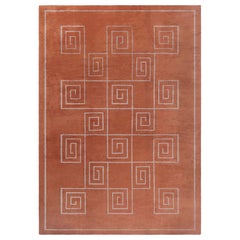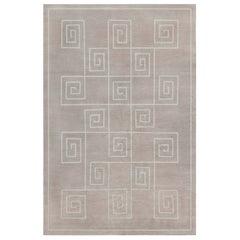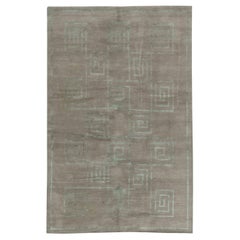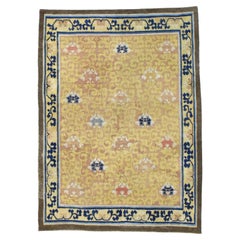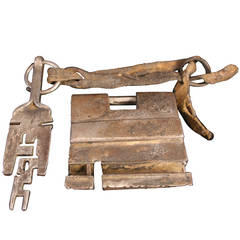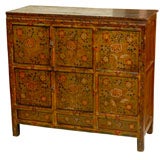Tibetan Key
Modern Deco-Inspired Tibetan Rug with Greek Key Motif by Doris Leslie Blau
Located in New York, NY
Modern Deco-Inspired Tibetan Rug with Greek Key Motif, Hand-Knotted in Wool and Silk by Doris
Category
21st Century and Contemporary Nepalese Tibetan Chinese and East Asian Rugs
Materials
Wool, Silk
$25,480 Sale Price
30% Off
W 164 in L 231 in
Modern Deco-Inspired Tibetan Rug with Greek Key Motif by Doris Leslie Blau
Located in New York, NY
Modern Deco-Inspired Tibetan Rug with Greek Key Motif, Hand-Knotted in Wool and Silk by Doris
Category
21st Century and Contemporary Nepalese Tibetan Chinese and East Asian Rugs
Materials
Wool, Silk
Modern Art Deco Tibetan Rug with Greek Key Design by Doris Leslie Blau
Located in New York, NY
Modern Art Deco Tibetan Rug with Greek Key Design by Doris Leslie Blau.
Size: 6'0" × 9'4" (182
Category
21st Century and Contemporary Tibetan Modern Chinese and East Asian Rugs
Materials
Wool, Silk
$6,272 Sale Price
30% Off
W 72 in L 112 in
Modern Art Deco Tibetan Rug with Greek Key Design by Doris Leslie Blau
Located in New York, NY
Modern Art Deco Tibetan Rug with Greek Key Design by Doris Leslie Blau.
Size: 6'0" × 9'4" (182
Category
21st Century and Contemporary Tibetan Modern Chinese and East Asian Rugs
Materials
Wool, Silk
Modern Art Deco Tibetan Rug with Greek Key Design by Doris Leslie Blau
Located in New York, NY
Modern Art Deco Tibetan Rug with Greek Key Design by Doris Leslie Blau
Size: 6'0" × 9'3" (182 × 281
Category
21st Century and Contemporary Indian Modern Indian Rugs
Materials
Wool
Antique Chinese Ningxia Rug Hand-Knotted Wool, 4'8"×6'4"
By Amara Rugs
Located in Torrance, CA
painterly aesthetic, harmonious palette, and historical ties to Tibetan and Chinese monastic traditions
Category
Antique 19th Century Chinese Chinese Chippendale Central Asian Rugs
Materials
Wool
Recent Sales
Antique Tibetan Lock and Key
Located in Hudson, NY
A working antique Tibetan lock with key. The key slides into the lock to open the pin. These types
Category
Antique Late 18th Century Tibetan Antiquities
Tibetan Chest
Located in Atlanta, GA
This is a four door, hand painted Tibetan chest with hand carved key fret design. Each panel on
Materials
Wood
Tibetan Tara Padlock with Dorje Keys
Located in Chicago, IL
19th-century Tibetan metalwork. The lock depicts the female bodhisattva known as Jetsun Dölma, or White
Category
Antique Mid-19th Century Tibetan Mounted Objects
Materials
Brass
Doris Leslie Blau Collection Modern Tibetan Greek Key Handmade Wool, Silk Rug
Located in New York, NY
Doris Leslie Blau collection modern Tibetan Greek key handmade wool, silk rug
Size: 10' × 13'8
Category
21st Century and Contemporary Nepalese Tibetan Chinese and East Asian Rugs
Materials
Wool, Silk
Red Polychrome Indonesian Cupboard with Doors and One Drawer and Keys
Located in Valladolid, ES
unique red. There are two doors, up and bottom and a drawer in the middle, 19th century. With key.
In a
Category
Antique 1890s Javanese Tibetan Furniture
Materials
Wood
H 66.93 in W 32.68 in D 14.18 in
Hand Knotted Wool and Silk Tibetan With Roman Key Design Oriental Rug
Located in Carlstadt, NJ
This is a truly genuine one-of-a-kind hand knotted wool and silk Tibetan with Roman key design
Category
2010s Nepalese Tibetan More Carpets
Materials
Silk
Vintage Tibetan Tiger-Shaped Rug in Bright Orange with Black, Red & Blue Accents
Located in Barrington, IL
embodies protection, strength, and spiritual authority—key themes in Tibetan Buddhist culture.
The rug
Category
Late 20th Century Tibetan Chinese and East Asian Rugs
Materials
Wool, Cotton
Get Updated with New Arrivals
Save "Tibetan Key", and we’ll notify you when there are new listings in this category.
Tibetan Key For Sale on 1stDibs
Find many varieties of an authentic Tibetan key available at 1stDibs. Each Tibetan key for sale was constructed with extraordinary care, often using fabric, wool and silk. Find 4 options for an antique or vintage Tibetan key now, or shop our selection of 6 modern versions for a more contemporary example of this long-cherished piece. Your living room may not be complete without a Tibetan key — find older editions for sale from the 18th Century and newer versions made as recently as the 21st Century. When you’re browsing for the right Tibetan key, those designed in Mid-Century Modern styles are of considerable interest.
How Much is a Tibetan Key?
A Tibetan key can differ in price owing to various characteristics — the average selling price 1stDibs is $5,860, while the lowest priced sells for $1,463 and the highest can go for as much as $26,000.
More Ways To Browse
Tibetan Dorje
Java Door
Antique Brass Padlock
Antique Brass Padlock With Key
Georg Jensen Bonbonniere
Georg Jensen Carving Set
Georg Jensen Chargers
Georg Jensen Creamer
Georg Jensen Decanter
Georg Jensen Jug
Georg Jensen Lobster
George Adams Cutlery
George Beaumont
George Ii Sauce Boat
George Iii Display Cabinet
George Iii Tallboy
George Nelson Omni Mid Century Wall Unit
George Nelson Omni Wall
